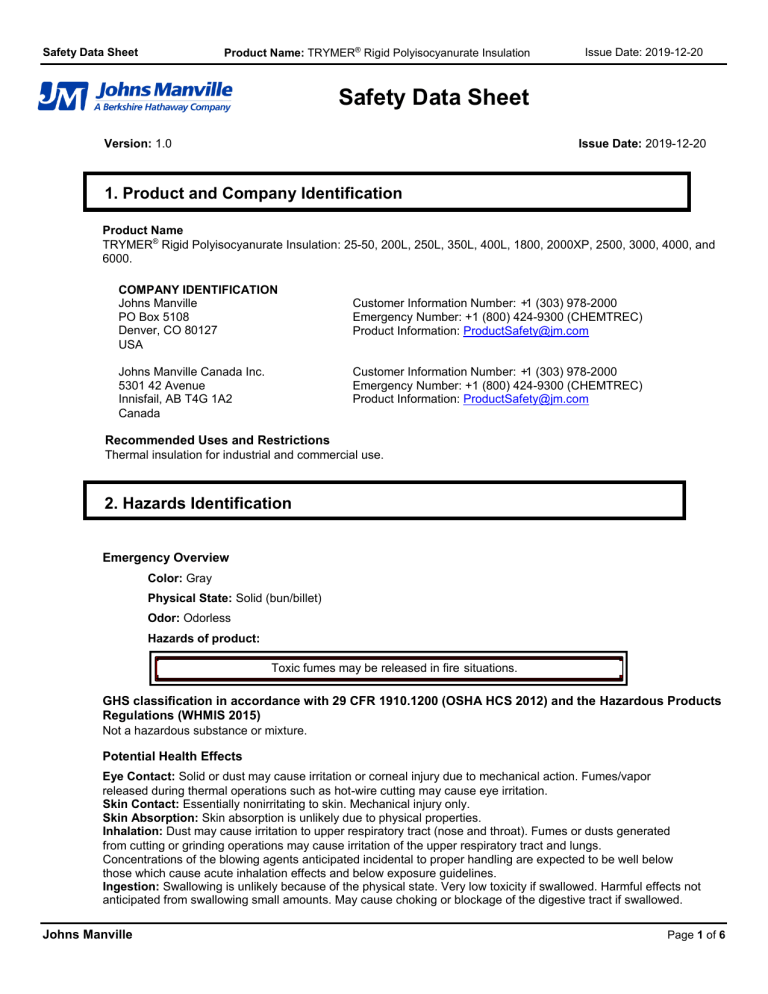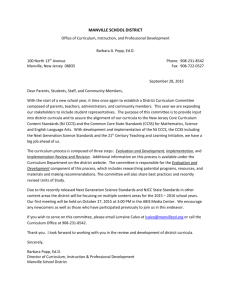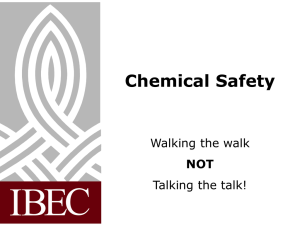
Product Name: TRYMER® Rigid Polyisocyanurate Insulation Safety Data Sheet Issue Date: 2019-12-20 Safety Data Sheet Version: 1.0 Issue Date: 2019-12-20 1. Product and Company Identification Product Name TRYMER® Rigid Polyisocyanurate Insulation: 25-50, 200L, 250L, 350L, 400L, 1800, 2000XP, 2500, 3000, 4000, and 6000. COMPANY IDENTIFICATION Johns Manville PO Box 5108 Denver, CO 80127 USA Johns Manville Canada Inc. 5301 42 Avenue Innisfail, AB T4G 1A2 Canada Customer Information Number: +1 (303) 978-2000 Emergency Number: +1 (800) 424-9300 (CHEMTREC) Product Information: ProductSafety@jm.com Customer Information Number: +1 (303) 978-2000 Emergency Number: +1 (800) 424-9300 (CHEMTREC) Product Information: ProductSafety@jm.com Recommended Uses and Restrictions Thermal insulation for industrial and commercial use. 2. Hazards Identification Emergency Overview Color: Gray Physical State: Solid (bun/billet) Odor: Odorless Hazards of product: Toxic fumes may be released in fire situations. GHS classification in accordance with 29 CFR 1910.1200 (OSHA HCS 2012) and the Hazardous Products Regulations (WHMIS 2015) Not a hazardous substance or mixture. Potential Health Effects Eye Contact: Solid or dust may cause irritation or corneal injury due to mechanical action. Fumes/vapor released during thermal operations such as hot-wire cutting may cause eye irritation. Skin Contact: Essentially nonirritating to skin. Mechanical injury only. Skin Absorption: Skin absorption is unlikely due to physical properties. Inhalation: Dust may cause irritation to upper respiratory tract (nose and throat). Fumes or dusts generated from cutting or grinding operations may cause irritation of the upper respiratory tract and lungs. Concentrations of the blowing agents anticipated incidental to proper handling are expected to be well below those which cause acute inhalation effects and below exposure guidelines. Ingestion: Swallowing is unlikely because of the physical state. Very low toxicity if swallowed. Harmful effects not anticipated from swallowing small amounts. May cause choking or blockage of the digestive tract if swallowed. Johns Manville Page 1 of 6 Safety Data Sheet Product Name: TRYMER® Rigid Polyisocyanurate Insulation Issue Date: 2019-12-20 3. Composition Information Component CAS # Amount Modified Polyisocyanurate Rigid Cellular Polymer Hydrocarbon blowing agent(s) Tris(1-chloro-2-propyl) phosphate Not applicable Not applicable 13674-84-5 ≥85.0% ≤10.0% ≤5.0% 4. First-Aid Measures Eye Contact: Flush eyes with plenty of water; remove contact lenses after the first 1-2 minutes then continue flushing for several minutes. Only mechanical effects expected. If effects occur, consult a physician, preferably an ophthalmologist. Skin Contact: Seek first aid or medical attention as needed. Inhalation: Move person to fresh air; if effects occur, consult a physician. Ingestion: If swallowed, seek medical attention. May cause gastrointestinal blockage. Do not give laxatives. Do not induce vomiting unless directed to do so by medical personnel. Notes to Physician: No specific antidote. Treatment of exposure should be directed at the control of symptoms and the clinical condition of the patient. 5. Fire Fighting Measures Extinguishing Media: Water. Dry chemical fire extinguishers. Carbon dioxide fire extinguishers. Fire Fighting Procedures: Keep people away. Isolate fire and deny unnecessary entry. Soak thoroughly with water to cool and prevent re-ignition. Cool surroundings with water to localize fire zone. Hand held dry chemical or carbon dioxide extinguishers may be used for small fires. Special Protective Equipment for Firefighters: Wear positive-pressure self-contained breathing apparatus (SCBA) and protective firefighting clothing (includes firefighting helmet, coat, trousers, boots, and gloves). If protective equipment is not available or not used, fight fire from a protected location or safe distance. Unusual Fire and Explosion Hazards: When product is stored in closed containers, a flammable atmosphere can develop. Mechanical cutting, grinding or sawing can cause formation of dusts. To reduce the potential for dust explosion, do not permit dust to accumulate. Rapid bursting of a multitude of cells such as might occur during compaction of product waste for disposal will release a flammable blowing agent which can lead to the development of a flammable atmosphere in inadequately vented equipment. This product contains a flame retardant to inhibit accidental ignition from small fire sources. This plastic foam product is combustible and should be protected from flames and other high heat sources. Dense smoke is emitted when burned without sufficient oxygen. Hazardous Combustion Products: During a fire, smoke may contain the original material in addition to combustion products of varying composition which may be toxic and/or irritating. In smoldering or flaming conditions, carbon monoxide, carbon dioxide and carbon are generated. Combustion products may include and are not limited to: Nitrogen oxides. Combustion products may include trace amounts of: Hydrogen cyanide. Hydrogen Halides. Aromatic hydrocarbons. 6. Accidental Release Measures Steps to be Taken if Material is Released or Spilled: Contain spilled material if possible. Collect in suitable and properly labeled containers. See Section 13, Disposal Considerations, for additional information. Personal Precautions: Use appropriate safety equipment. For additional information, refer to Section 8, Exposure Controls and Personal Protection. Environmental Precautions: Prevent from entering into soil, ditches, sewers, waterways and/or ground water. See Section 12, Ecological Information. Johns Manville Page 2 of 6 Safety Data Sheet Product Name: TRYMER® Rigid Polyisocyanurate Insulation Issue Date: 2019-12-20 7. Handling and Storage Exposure Limits Component List Type Value Cyclopentane ACGIH TWA 600 ppm Isopentane ACGIH TWA 1,000 ppm General Handling This material is combustible and should not be exposed to flame or other ignition sources. Refer to Exposure Controls and Personal Protection, Section 8 of the SDS. No smoking, open flames or sources of ignition in handling and storage area. Fabrication methods which involve cutting into this product may release the blowing agent(s) remaining in the cells. Provide adequate ventilation to assure localized concentrations in release areas are maintained below the lower flammable limit. Other Precautions Good housekeeping and controlling of dusts are necessary for safe handling of product. Storage Keep in a cool, well-ventilated place. Minimize sources of ignition, such as static build-up, heat, spark or flame. Flammable vapors may accumulate in some storage situations. During shipment, storage, installation, and use, this material should not be exposed to flame or other ignition sources. 8. Exposure Controls / Personal Protection Concentrations of the blowing agents anticipated incidental to proper handling are expected to be well below those which cause acute inhalation effects and below exposure guidelines. Personal Protection Eye/Face Protection: Eye protection should not be necessary. For fabrication operations safety glasses are recommended. If there is a potential for exposure to particles which could cause eye discomfort, wear chemical goggles. Skin Protection: No precautions other than clean body-covering clothing should be needed. Hand protection: Use gloves to protect from mechanical injury. Selection of gloves will depend on the task. Respiratory Protection: Atmospheric levels should be maintained below the exposure guideline. When respiratory protection is required for certain operations, use a NIOSH-approved air-purifying respirator. In dusty or misty atmospheres, use a NIOSH-approved particulate respirator. The following should be effective types of air-purifying respirators: Particulate filter. Ingestion: No precautions necessary due to the physical properties of the material. Engineering Controls Ventilation: Provide general and/or local exhaust ventilation to control airborne levels below the exposure guidelines. 9. Physical and Chemical Properties Physical State Color Odor Flash Point - Closed Cup Flammable Limits In Air Autoignition Temperature Johns Manville Solid (bun/billet) Tan Odorless Not applicable Lower: Not applicable Upper: Not applicable 490 °C (914 °F) ASTM D1929 Page 3 of 6 Safety Data Sheet Product Name: TRYMER® Rigid Polyisocyanurate Insulation Vapor Pressure Boiling Point (760 mmHg) Vapor Density (air = 1) Specific Gravity (water = 1) Freezing Point Melting Point Solubility in Water pH Kinematic Viscosity Issue Date: 2019-12-20 Not applicable Not applicable Not applicable 0.02 - 0.05 Estimated Not applicable > 150 °C (> 302 °F) Estimated, Decomposes Insoluble in water Not applicable Not applicable 10. Stability and Reactivity Stability/Instability Thermally stable at typical use temperatures. Conditions to Avoid Avoid temperatures above 150 °C (302 °F). Exposure to elevated temperatures can cause product to decompose. Avoid direct sunlight. Incompatible Materials Avoid contact with strong oxidizers. Hazardous Polymerization Will not occur. Thermal Decomposition Decomposition products depend upon temperature, air supply and the presence of other materials. Toxic gases are released during decomposition. 11. Toxicological Information Repeated Dose Toxicity Repeated exposures to dusts of this material are not anticipated to result in systemic toxicity or permanent lung injury; however, excessive exposures may cause less severe respiratory effects. 12. Ecological Information CHEMICAL FATE Movement & Partitioning No bioconcentration is expected because of the relatively high molecular weight (MW greater than 1000). In the terrestrial environment, material is expected to remain in the soil. In the aquatic environment, material is expected to float. Persistence and Degradability Surface photodegradation is expected with exposure to sunlight. No appreciable biodegradation is expected. ECOTOXICITY Not expected to be acutely toxic to aquatic organisms. Johns Manville Page 4 of 6 Safety Data Sheet Product Name: TRYMER® Rigid Polyisocyanurate Insulation Issue Date: 2019-12-20 13. Disposal Considerations Dispose of contents/container to an approved facility in accordance with local, regional, national and international regulations. 14. Transport Information DOT (Bulk / Non-Bulk) NOT REGULATED TDG (Bulk / Non-Bulk) NOT REGULATED IMDG NOT REGULATED ICAO/IATA NOT REGULATED 15. Regulatory Information GHS classification in accordance with 29 CFR 1910.1200 (OSHA HCS 2012) and the Hazardous Products Regulations (WHMIS 2015) Non-hazardous according to 29 CFR 1910.1200 (OSHA HCS 2012) and the Hazardous Products Regulations (WHMIS 2015), when used as intended. Superfund Amendments and Reauthorization Act of 1986 Title III (Emergency Planning and Community Right-to-Know Act of 1986) Sections 311 and 312 Immediate (Acute) Health Hazard Delayed (Chronic) Health Hazard Fire Hazard Reactive Hazard Sudden Release of Pressure Hazard No No No No No Superfund Amendments and Reauthorization Act of 1986 Title III (Emergency Planning and Community Right-to-Know Act of 1986) Section 313 To the best of our knowledge, this product does not contain chemicals at levels which require reporting under this statute. California Proposition 65 (Safe Drinking Water and Toxic Enforcement Act of 1986) This product does not require a warning under the California Safe Drinking Water and Toxic Enforcement Act (Proposition 65). Toxic Substances Control Act (TSCA) All components of this product are on the TSCA Inventory or are exempt from TSCA Inventory requirements under 40 CFR 720.30. CEPA - Domestic Substances List (DSL) All substances contained in this product are listed on the Canadian Domestic Substances List (DSL) or are not required to be listed. Johns Manville Page 5 of 6 Safety Data Sheet Product Name: TRYMER® Rigid Polyisocyanurate Insulation Issue Date: 2019-12-20 16. Other Information Revision Revision Date: 2019-12-20 Legend TWA ACGIH Time Weighted Average American Conference of Governmental Industrial Hygienists The information provided in this Safety Data Sheet is correct to the best of our knowledge, information and belief at the date of its publication. The information given is designed only as a guidance for safe handling, use, processing, storage, transportation, disposal and release and is not to be considered a warranty or quality specification. The information relates only to the specific material designated and may not be valid for such material used in combination with any other materials or in any process, unless specified in the text. Johns Manville Page 6 of 6


